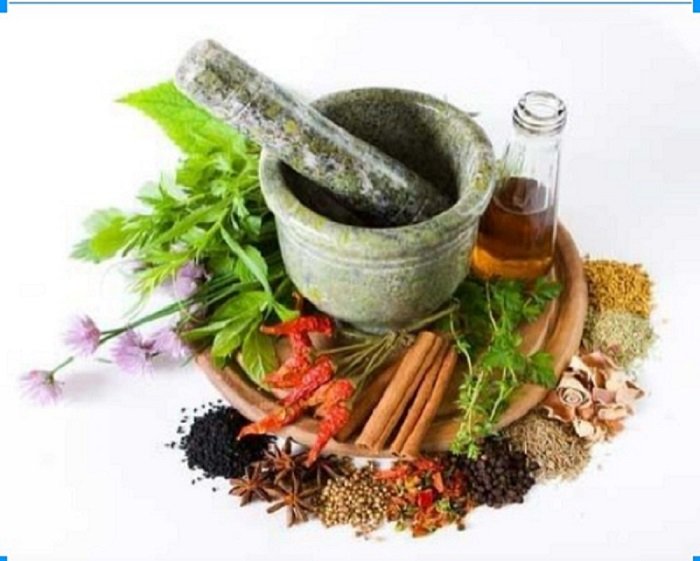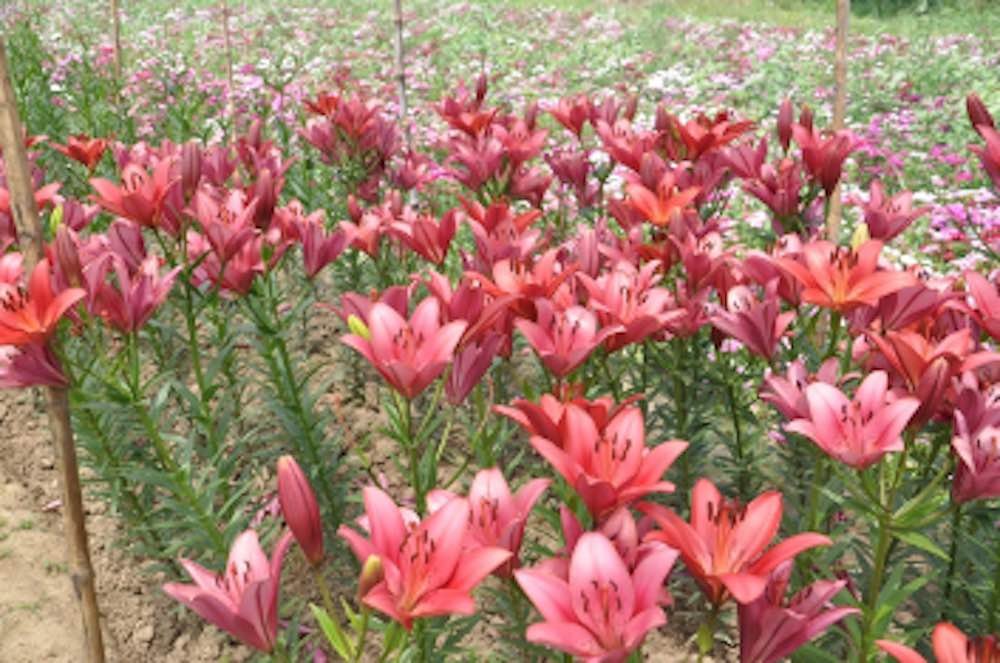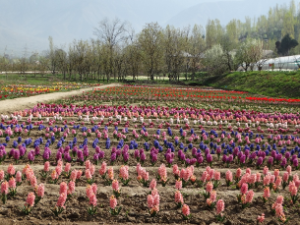Opinion
Let’s Revive the Organic way of Healing
Published
3 years agoon
By
BK Editor




The Himalayas are identified as one of the global biodiversity hotspots, with high species richness due to ecological, phytogeographic, and evolutionary factors. There are around 18,440 plant species (25.3 % of which are indigenous), 1748 medicinal plant species, and 675 wild edible species. For populations living in mountainous locations, collecting and, more lately, marketing MAPs has offered a significant source of income. The long-term viability of such plants is inextricably linked to future Himalayan potential. Plants are still used for primary healthcare in many cultures around the world, and medicinal herbs have long been used in traditional healthcare systems. With recent developments in plant sciences, the usage of plant-based health products has increased dramatically in both developing and industrialized countries. Around the world, 70–80% of people use medicinal plants as their primary health care. The demand for medical plant-based raw materials is increasing at a pace of 15 to 25% per year and is expected to exceed $5 trillion by 2050. The medicinal plant trade in India is estimated to be worth around $1 billion per year. The World Health Organization tried to identify all medical plants used worldwide and identified over 20,000 species. Kashmir Himalayas has a diverse range of medicinal plants due to topographical diversity.
JAMMU & KASHMIR AS HERBAL DRUG STORE
Jammu and Kashmir (J&K), an Indian Himalayan state, is rich in biodiversity with a rich medicinal flora. The Kashmir valley referred to as Terrestrial Paradise has abundant biodiversity that adorns Kashmir’s beauty. The region is endowed with a rich diversity of medicinal plants due to its phyto-geographical location within the North-Western Himalayas. The scientific documentation of medicinal flora diversity, distribution, and traditional usage could be crucial in the conservation and long-term utilization of these valuable plant resources in this Himalayan state. Some of the medicinal plants that are widely found in Jammu and Kashmir include Aconitum heterophyllum, Berberis aristata, Artemesia absinthium, Atropa acuminata, Trillium govanianum, Saussurea costus, Picrorhiza kurroa, Withania somnifera, Acorus calamus; among the most significant aromatic herbs are Levandula officinalis, Rosmarinus officinalis, Organium vulgare, Podophyllum hexandrum, Hippophae rhamnoides, Dactylorhiza hatagirea, and Arnebia benthamii. Medicinal and aromatic plants (MAP) conservation and production are becoming increasingly important. In India, MAPs are collected/cultivated in a variety of climate and soil conditions, ranging from the seacoast to the high Himalayas. The preservation and development of medicinal and aromatic plants is a top priority in Jammu, Kashmir, and Ladakh, which represent temperate, alpine, and cold dry region zones.The medicinal plant market is still developing and is largely unregulated. Local residents in the region collect and trade medicinal herbs in order to meet their basic requirements for livelihood. According to local medicinal plant collectors and traders, demand for particular species such as Aconitum heterophyllum, Angelica glauca, Podophyllum hexandrum, Ephedra gerardiana, and Saussurea costus is quite high, but supply is low due to rare populations and lack of cultivation.
MEDICINAL & AROMATIC PLANTS SIGNIFICANCE: NATURE’S MEDICINE
Medicinal plants are rapidly becoming valuable bio-resource. Without a doubt, their effectiveness in managing human ailments while causing no negative effects has earned a widespread reputation for these useful species. Given the high cost and side effects of modern medicine, traditional knowledge and practices of medicinal plants against various diseases, such as asthma, diarrhoea, throat infections, rheumatism, ulcer, poliomyelitis, abdominal pain, body swellings, cough, burns, wounds, allergies, general weakness, etc., are extremely important. Some of the medicinal plants, including Rheum species, Artemisia species, Ephedra species, and Salvia species, have been demonstrated in recent scientific studies to be useful in treating COVID-19.
DEVELOPMENTAL STRATEGIES FOR THE HERBAL MEDICINE INDUSTRY
The growth of sustainable medicinal herbs offers a great chance to capitalize on the growing market while guaranteeing a consistent supply for local communities. Industry growth strategy for herbal medicine over 100 million hectares of wastelands are currently idle, depriving the income generating options while also posing a major threat to the ecosystem and environment. These kinds of lands can be used to grow medicinal herbs, which are in high demand. Establishing contact with bulk consumers can help to boost commercial medical herb cultivation. The following actions are recommended for a successful promotion of the herbal medicine business in Jammu & Kashmir.
- Plant species with therapeutic characteristics need to be identified and herbariums should be established.
- Assessment of demand & supply status relating to medicinal plants.
- Standardization of propagation and cultivation procedures in order to produce superior grade herbal materials.
- Validation for the use of numerous medicinal herbs in the treatment of various ailments, as well as standardization of protocols and documentation.
- Assisting collectors and growers to store, transport and market their herbal products.
- Research to develop effective herbal medications to treat diverse ailments, particularly newly emerging diseases, should be strengthened.
- Herbal medicine should be taught as a core subject in medical schools that deal with various systems.
- Popularization of diverse herbal medications through workshops, training, social marketing, and public awareness.
- Establishing primary processing, grading, marketing, and other facilities in coordination with local stakeholders and organizations.
- Traditional healers and Ayurveda practitioners should be supported through knowledge sharing, networking, the provision of superior quality germplasm, and connections with farmers for raw material supply.
The demand for medicinal herbs has risen dramatically in recent years on both national and international markets. Traditional medicines have seen a return in popularity in recent decades, both as alternative cures and in the pharmaceutical industry. There seems to be a lack of attention in current research to maintain the sustainable use of these valuable plant species. Plant species that only grow in the wild and are not cultivated, need to be conserved. The long-term protection and sustainable use of their source species must be prioritized if plant elements to promote human health are to be made available in the future.
Writers are research scholars from SKUAST Kashmir
You may like
-




Blossom at Risk | Climate Change and Its Impact on Floriculture
-




SMHS incident: When hope turns to rage
-




RBI penalises Central Cooperative Banks Baramulla, Anantnag for violations
-




Editorial | J&K Budget 2025-26 – A Balancing Act
-




CII J&K Organizes Health Conclave 2024
-




Kya kuchh tha jiske kehne ko: A tribute to father
AgriBiz
Blossom at Risk | Climate Change and Its Impact on Floriculture
Published
4 months agoon
July 30, 2025By
BK Editor

Dr Zahoor Ahmed Rather
Prof Imtiyaz Tahir Nazki
Blossom at Risk
The global environmental agencies declared 2024 the hottest year and over the course of the last century, the average surface temperature of earth has increased, amounting to around 0.74 0C.As per the Economic Survey, India is the seventh most vulnerable country to climate change and faced severe weather extremes, with 93% of days in 2024 marked by extreme climate events such as heatwaves, cyclones, and floods. As the world grapples with the phenomenon of climate change, one of the most visually striking yet often overlooked casualties is the floriculture industry. From tulips in the Netherlands to roses in Kenya, the delicate balance required for flower cultivation is being disrupted by rising temperatures, erratic weather patterns, and shifting ecosystems. The floriculture industry employs millions of people, from small-scale farmers in developing countries to large-scale exporters in Europe and Asia. The decline in flower quality and quantity due to climate change could have far-reaching consequences not only affecting global flower supplies but also small-scale flower growers, being the backbone of this industry, and may be forced out of business. At present, 1191 growers registered with Department of Floriculture (J&K) are active in commercial floriculture business generating an income of Rs. 19.42 crores (2023-24) which is under threat due to climate change.
The Kashmir’s temperate climate, fertile soil, and glacial waters have nurtured a flourishing floriculture industry with an area of about 431.25 ha alone under gardens, parks and lawns, attracting tourists all over world. Kashmir once celebrated as the “Garden of Eden” for its riot of colors and fragrances, isnow slowly turning into a battleground where nature and climate change are stuck in a grim struggle. Extreme weather events, like unseasonal frosts, irregular precipitation patterns, prolonged droughts and increased evaporation rates are becoming more frequent. One of the immediate consequences of climate change in Kashmir is the disruption of traditional weather cycles.


The most significant impacts of climate change are the alteration of crop blooming cycles. A shorter blooming season, improper floral growth and colour development, and insufficient flowering are all problems associated with commercial flower cultivation, especially under open field conditions. Thus flower crops like tulip, marigold, gladiolus, annuals grown under open conditions will be greatly affected by these erratic weather changes. Among ornamental crops, flowering bulbs are considered as vital indicators of climate change due to their sensitivity to minor seasonal cues and temperature changes. Warmer temperatures are causing flowers to bloom earlier than usual, disrupting supply chains and affecting seasonal markets. Spring flowering bulbs viz., tulips, daffodils and crocuses are among the first plants to signal the onset of spring, have been observed blooming earlier than historical averages. Warmer winters have caused premature bud formation making them highly susceptible to unexpected frost. Ornamentals such as tulips, daffodils, magnolia, irises which need chilling temperature for flowering are adversely affected. Under present scenario of mild winter and warm spring, the bulb yield oftulip is expected to hit badly. On the other hand, summers, with prolonged unexpected heat waves have also disruptedthe normal blooming process of flowers. These conditions lead to shortening of flower duration and deterioration of aesthetic and commercial value.
Temperature extremes not only influence the timing and quantity of flowering but also affect flower quality including volatile fragrances of flowers. Temperature at low to medium range plays a critical role in pigment production especially anthocyanin which contributes to the vibrant colours of flowers. The extreme temperature has also been linked to declining number of flowering buds and smaller flower diameters in species like Antirrhinum majus and Impatiens walleriana. Any unusual change in photoperiodism and thermoperiodism due to climate change would result in a significant deviation in the flowering patterns of plants such as carnations, chrysanthemums, and poinsettias.
The plant hardiness zones have also been observed to move northward or upwards in response to rising temperatures. Diversity of some alpine species has become vulnerable and their distribution is gradually narrowed. The rhododendrons and other woody ornamentals of lower hills have begun to invade the alpine areas thus changing the composition of plant population. Changes in the timing, duration, and abundance of flowering have the potential to disrupt ecological relationships among plants, pollinators, herbivores, flower parasites and pathogens.
Rising temperatures, altered precipitation patterns and increased humidity create favourable conditions for outbreak of pests and diseases by expending habitat range that can cause damage to ornamental plants at high scale. This can pose a significant challenge to sustain quality production in floriculture, thus requiring integrated approaches to devise management strategies.


The plight of Kashmir’s floriculture is a microcosm of the global climate crisis. Despite the challenges, the floriculture industry has to adopt innovative approaches to combat climate change. Farmers can take up greenhouse cultivation to have better control of temperature and humidity and drought-resistant flower crops along with precision farming practices like drip irrigation etc. The modern approaches like roof and vertical gardening can play an important role in improving air quality, and reducing surface temperature in the built environment, costs for heating or cooling of building and noise pollution. Interior landscape plants are also useful to enhance indoor environmental quality and improve workplace efficiency. Development of public parks and lawns enriched with native flora improves air quality, mitigate health risk and maintain species diversity. The AI-powered systems can also be used to monitor and optimize the growing conditions of high value crops. Therefore, the future of Kashmir’s floriculture depends on collaborative efforts across all sectors. Policymakers, researchers, and industry leaders must join their hands to work together to execute policies and practices that promote sustainability and protection of the region’s floral heritage and tourism industry associated with it.
The authors are faculty at SKUAST-K’s Division of Floriculture and Landscape, Shalimar. zahoor.rthr@gmail.com
Opinion
Ethical Consumerism And Organic Market Nexus
Published
4 months agoon
July 26, 2025By
BK Editor

Dr Binish Qadri
Malik Daniyal Shabir
The choices consumers make today are no longer limited to price and utility. Increasingly, purchasing decisions are being shaped by deeper concerns—about the environment, labour ethics, health, and long-term sustainability. This shift in consumer consciousness has brought ethical consumerism to the forefront of economic and social discussions. Ethical consumerism, at its core, is a form of activism. It transforms everyday market behaviour into a statement of values, where individuals engage with the marketplace not just as buyers, but as participants in shaping a more equitable and sustainable world.
One area where the impact of ethical consumerism is especially visible is the organic market. Organic food is not just about pesticide-free vegetables or hormone-free milk; it represents a broader commitment to a way of life that values nature, fairness, and health. The rise of the organic market is not merely a trend, but a response to a collective moral impulse—one that sees food as a gateway to better living for individuals and communities alike.
Ethical consumerism is not an entirely new phenomenon. It can be traced back to movements like boycotts of slave-produced sugar in the 18th century and, later, fair-trade campaigns in the 20th century. As globalisation expanded markets, it also exposed consumers to the darker side of production—sweatshops, deforestation, animal cruelty, and chemical abuse. Simultaneously, the organic farming movement took root, driven by concerns over synthetic fertilisers, pesticides, and declining soil health. What began as a fringe movement soon gained traction with the rise of environmental activism and public health awareness. In India, government recognition and consumer interest have boosted organic farming policies and local organic brands. Together, these developments forged a shared moral and ecological ground between ethical consumerism and the organic movement.
Organic food is not just about pesticide-free vegetables or hormone-free milk; it represents a broader commitment to a way of life that values nature, fairness, and health. The rise of the organic market is not merely a trend, but a response to a collective moral impulse—one that sees food as a gateway to better living for individuals and communities alike.
Health has long been a personal concern, but in recent years it has also taken on moral dimensions. The link between food choices and long-term well-being is clearer than ever, and consumers are beginning to view the act of buying food as an ethical choice. Rising rates of lifestyle diseases, antibiotic resistance, and food adulteration have forced many to question conventional agricultural systems. Organic food offers an alternative that aligns with both personal and societal health goals. Choosing food grown without harmful chemicals becomes not just a self-protective act but a gesture of solidarity toward a cleaner environment and a healthier community. In this light, the push for organic food becomes not merely a dietary decision but a reflection of a broader ethical framework.
There is a complementarity between ethical consumerism and the organic market. Both affect and get affected by each other. The consumption of organic food has moral considerations, such as health and social concerns including the environment and sustainability. Agricultural economics is witnessing a rising trend and craze for organic food, which is visible in the shift in the consumer taste and demand towards organic food. The mounting health issues among general population, especially among young folks are pressing hard for development of the organic market. Consumers are the king of the market who increasingly see organic food as a way to support eco-friendly or sustainable farming practices, safeguard the environment, and avoid chemicals linked to traditional farming.
As far as ethical consumers are concerned, they are often inspired by concerns about environmental impact, human rights, human freedom, and animal welfare, which coincides with the organic farming canons. In other words, they are bothered about the holistic socio-environmental and animal welfare outcomes of their purchasing power decisions. They give importance to the goods that are in accordance with their ethics and moral values, including environmental sustainability and objective labour activities. This contains refraining from goods from firms with a bad reputation or buying from firms displaying moral conduct right from scratch. They pay a pivotal role in promoting sustainable development, meeting needs of the present generation without compromising the needs of the future generations. They provide backup to ethical trade and commerce. They give top priority to companies with a great ethical background and sustainability principles, giving a clear-cut message that moral values are above all. Moreover, they stimulate demand for sustainable goods. They prefer fair-trade goods, organic food, and sustainable goods, and accordingly, create a demand for sustainable substitutes, promoting innovations (especially green innovation) and produce sustainable and green goods. The moment they do away with those companies that promote unethical and unsustainable practices, they basically drive a long path towards sustainable development. It has a dual effect: On one hand, it restricts child labour and immoral labour practices and on the another hand, it reduces environmental degradation. Furthermore, ethical consumers can promote environmental responsibility by raising awareness about social and environmental issues. They always prefer well-informed choices, thereby empowering consumers in every possible manner. By making informed choices, they be held personally responsible for their actions impact on the social systems and environment.
In states like Sikkim, which declared itself fully organic in 2016, consumer support and political will came together to build an ecosystem that values soil health, farmer welfare, and chemical-free produce. Farmer cooperatives and weekend organic markets in cities like Bengaluru, Pune, and Delhi have become popular precisely because they appeal to a consumer base that wants its spending to reflect its values. These cases show that ethical consumption is more than a concept—it is a living force with the power to transform how food is grown and consumed.
Across the globe and within India, the convergence of ethical values and organic preferences is reshaping markets. Brands like Organic India and 24 Mantra Organic owe much of their success to ethically conscious consumers who demand transparency, sustainability, and purity. In states like Sikkim, which declared itself fully organic in 2016, consumer support and political will came together to build an ecosystem that values soil health, farmer welfare, and chemical-free produce. Farmer cooperatives and weekend organic markets in cities like Bengaluru, Pune, and Delhi have become popular precisely because they appeal to a consumer base that wants its spending to reflect its values. In states like Sikkim, which declared itself fully organic in 2016, consumer support and political will came together to build an ecosystem that values soil health, farmer welfare, and chemical-free produce. Farmer cooperatives and weekend organic markets in cities like Bengaluru, Pune, and Delhi have become popular precisely because they appeal to a consumer base that wants its spending to reflect its values. These cases show that ethical consumption is more than a concept—it is a living force with the power to transform how food is grown and consumed.
While the growth of ethical consumerism and the organic market is promising, it is not without obstacles. One major challenge is greenwashing—where companies falsely advertise their products as ethical or organic, misleading well-meaning consumers. There is also a cost barrier: organic and ethically produced goods are often more expensive, making them inaccessible to a large section of the population. Certification standards vary, and not all organic products undergo rigorous verification, creating confusion and mistrust. Moreover, the effectiveness of ethical consumerism hinges on access to information. In many regions, consumers lack the knowledge or tools to make informed choices, limiting the reach of these movements. These challenges must be addressed to sustain momentum and ensure that ethical consumerism remains a genuine force for good.
The relationship between ethical consumerism and the organic market is not incidental—it is deeply rooted in shared values and mutual influence. Ethical consumers drive demand for organic products, while the organic market offers them a platform to express their values through everyday choices. Together, they form a powerful nexus capable of reshaping economies, societies, and ecosystems. To deepen this impact, there is a need for stronger regulations, better consumer education, and more inclusive pricing strategies. Only then can this movement become not just the preference of a few but a sustainable norm for the many.
Dr Binish Qadri is former Assistant professor, Cluster University Srinagar and Malik Daniyal Shabir is an undergraduate student at the University of Delhi. They can be reached at qadribinish@gmail.com
Editorial
SMHS incident: When hope turns to rage
Published
4 months agoon
July 24, 2025By
BK Editor

The incident at SMHS Hospital, where an attendant assaulted a doctor after their patient reportedly died due to neglect, highlights a deeply troubling and complex issue within our healthcare system. While any act of violence is unequivocally unacceptable, this event serves as a stark reminder of the underlying frustrations and systemic failures that often lead to such desperate outbursts.
The core of the problem lies in the perceived lack of empathy and adequate care provided by medical professionals, particularly during critical situations. For doctors, dealing with illness and death may become a routine, a part of their daily professional lives. However, for a patient and their family, a critical illness is a life-altering, highly emotional, and often terrifying experience. The disconnect between these two realities is profound. When a patient, who has come to the hospital as a last resort, feels unheard, neglected, or that their loved one is not receiving the attention they desperately need, the sense of helplessness can quickly turn into anger and despair.
The situation in emergency wards across major city hospitals like SKIMS, SMHS, Bone & Joint, and Lal Ded is indeed dire. Overcrowding, coupled with a severe shortage of senior doctors and specialists, places an immense burden on the few junior doctors who are often left to manage a deluge of critical cases. This not only compromises the quality of care but also contributes to the stress and burnout among the medical staff, potentially leading to the very behaviour that patients and attendants find so distressing. Work pressure, long hours, and inadequate resources are often cited as reasons for a lack of bedside manner, but these reasons, while understandable to an extent, do not alleviate the suffering of those seeking help.
It is abundantly clear that a fundamental shift is desperately needed in how our hospitals, particularly emergency and critical care units, operate. The government must initiate a comprehensive re-evaluation and overhaul of the entire system. This overhaul is not merely a suggestion; it is an urgent imperative.
The core of the problem lies in the perceived lack of empathy and adequate care provided by medical professionals, particularly during critical situations. For doctors, dealing with illness and death may become a routine, a part of their daily professional lives. However, for a patient and their family, a critical illness is a life-altering, highly emotional, and often terrifying experience. The disconnect between these two realities is profound. When a patient, who has come to the hospital as a last resort, feels unheard, neglected, or that their loved one is not receiving the attention they desperately need, the sense of helplessness can quickly turn into anger and despair.
A significant increase in staffing is non-negotiable. We need more doctors, nurses, and support staff, especially in emergency departments, to ease the crushing workload and ensure that medical professionals can dedicate the necessary time and attention to each patient.
The constant presence of senior doctors and specialists in emergency and critical care units is paramount. Their invaluable experience and expertise are crucial for accurate diagnoses, timely interventions, and effective management of complex cases that junior doctors alone cannot always handle.
Furthermore, beyond medical proficiency, there is an urgent need for improved training in patient communication and empathy for all hospital staff. This includes equipping them with skills to convey information clearly, manage expectations compassionately, and demonstrate genuine concern, even amidst the most chaotic situations.
Addressing the pervasive overcrowding demands an upgrade in infrastructure and equitable resource allocation. This means more beds, modern equipment, and better-organised waiting areas. Resources must be strategically distributed to ensure that all necessary tools and medications are readily available when lives hang in the balance.
Establishing clear and accessible grievance redressal mechanisms is crucial. Patients and their attendants need effective channels to voice their concerns without fear. A robust system for addressing complaints proactively can prevent frustrations from escalating into unfortunate incidents like the one witnessed at SMHS.
Finally, while supporting our medical community, there must also be a culture of accountability. Instances of negligence and unprofessional conduct must be addressed appropriately to rebuild and maintain the vital trust between the medical fraternity and the public it serves.
The recent incident at SMHS Hospital is a symptom of a much larger systemic illness. It is a distress signal that demands immediate and comprehensive action. Patients come to hospitals with hope, seeking solace and healing. It is the government’s responsibility to ensure that this hope is met with professional care, empathy, and a system that prioritizes human life above all else. Failing to do so will only perpetuate a cycle of frustration, anger, and further erosion of public trust in our healthcare institutions.


Blossom at Risk | Climate Change and Its Impact on Floriculture


Ethical Consumerism And Organic Market Nexus


SMHS incident: When hope turns to rage


RBI penalises Central Cooperative Banks Baramulla, Anantnag for violations


Editorial | J&K Budget 2025-26 – A Balancing Act


Building FPO Leaders: SKUAST-K, MANAGE Hyderabad complete trainers’ training


CII J&K Organizes Health Conclave 2024


SKUAST-K to hold mega Science Summit on Aug 23-24


Haryana Biodiversity Board commemorates International Biodiversity Day at GNK Group Of Institutions


Kya kuchh tha jiske kehne ko: A tribute to father
Trending
-



 Industry5 years ago
Industry5 years agoFCIK hails LG Sinha for creating entrepreneur-friendly industrial ecosystem
-



 Economy3 years ago
Economy3 years agoGlobal eCommerce boom and local traders of Kashmir
-



 Energy5 years ago
Energy5 years agoLt Governor discusses J&K power scenario with experts
-



 Infra5 years ago
Infra5 years agoSKUAST-K bags EU project for urban green infrastructure
-



 AgriBiz5 years ago
AgriBiz5 years agoSKUAST-K to set up 3 honey testing labs in Kashmir
-



 Review5 years ago
Review5 years agoScam 1992: Story of the Big Bull of Share Market
-



 Jobs5 years ago
Jobs5 years agoJ&K Govt holds Industry Connect Meet-Himayat 2020
-



 Careers5 years ago
Careers5 years agoSKUAST-K holds career counselling at Wadura campus

